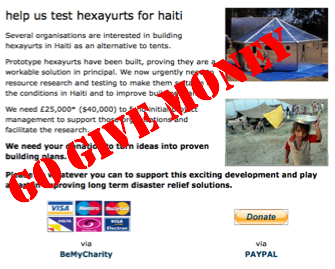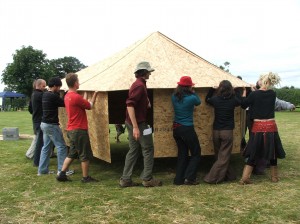The Smart Money – invest in changing how we approach disaster
by Vinay Gupta • February 14, 2010 • Everything Else • 1 Comment
TL;DR we’re raising money to do the science required to put hexayurts on the ground in Haiti. you can help by giving Science for Humanity the cash for the research drive.
======= THE DETAILS =======
If you prefer, a Spanish translation from Lucas Gonzalez
The Hexayurt Project is not a charity. It is not a business. It’s an open source project, with the same legal status as an unincorporated group of people writing software together and releasing that software into the public domain with each release. What we’re releasing isn’t software, but ideas, understanding and design.
A historical digression. I never anticipated being a disaster relief guy. I stumbled across the hexayurt’s shape in 2002 and was ideally positioned at RMI to understand the full significance of it, being conditioned to think in nation-state level whole systems, which is pretty much the RMI syllabus. I didn’t just see the shelter, I saw the whole supply chain – we can build as many of these as we need on the drop of a hat. That was a big deal. The shelter was a big deal. So I changed the course of my life to include it. I changed my “destiny” to support the hexayurt, and all the people it might help, but I did not start out with this as my goal.
Right place, right time, and here we are.
The Hexayurt Project has never really taken money. Yes, we’ve had a donation box up on the web site at times. I think we raised about $200 in five years. It just sat there, dormant, and occasionally paid our web hosting bills. There’s a reason for this. If you are a charity, there’s an enormous overhead: two, in fact. The first is the Directors / Board / Trustees who have fiduciary responsibility for every penny that comes in the door, and generally shackle whatever entrepreneurial vision was present at the beginning of the charity start up. The second is the donor public.
Typically charities appeal to the heart. They raise funds based on emotion. I’m not a particularly easy person to sway, and I always thought that this approach was basically advertising.
So I looked at that path – “Give a Hexayurt!” – and decided it wasn’t for me. I’d rather build tools for other people to go and take to the charitable donations market, than wind up with a board on one side and donors on the other pulling the project out of shape as so often happens with well-intentioned charitable start ups.
Instead I went to where the real money is: the military. I wound up helping to start STAR-TIDES, a cutting-edge military humanitarian network, and the Hexayurt Project Six Ways To Die model became an integral part of STAR-TIDES (see page 2, “infrastructure.”) And this stuff is going well, but it’s very slow. My model is that years pass – five, maybe ten – and then somebody moves five or ten million dollars, and suddenly the whole of appropriate technology, not just the hexayurt, is a military core competence. But real change at the military is an intergenerational effort. But they are coming. Slowly.
Radical change is necessary. Refugee camps have looked the same for a hundred years. Army surplus tents or close equivalents, in neat rows (UN) or higgledy-piggledy encampments, and then the tents rot and are replaced, or the people move to mud and straw or similar. When you’re dealing with extreme poverty, the “quick fix” of the tent is no good because these people aren’t going home any time soon – it will take them years to have enough money to rebuild their lives. In the mean time, a tent isn’t adequate shelter.
Haiti is a critical situation. They have 10% of their population homeless right now. 1 in 10. Jobless… probably the event will bankrupt the whole country because all of those people are now unemployed. We’ve escalated from a natural disaster to a state failure situation, basically. In this situation, we have some real needs, and some imagined ones.
The real needs are very simple: food, shelter, water, sanitation. And those need to be provided for in an enduring way, three, four, five, six years because that’s how long it will take for people to get back on their feet and the economy to recover.
The imaginary needs are also very simple: a rebuilt Port au Prince which looks just like it did before the disaster.
If we get the shelter and infrastructure right, the money from the international community can lay the bedrock for a new Haiti, a Haiti that works for everybody, not only the richest.
So this is why, after all these years, Hexayurt Project is asking for money. Here’s what we want to do:
1> Get a set of plans for a Hexayurt for Haiti engineered. It’s going to have to stand up to hella strong winds, and it’s going to have to last for years in termite territory. We’re pretty sure we know how to do this, but there’s a line past which you want a working structural engineer, finite element analysis, and a signed set of plans.
2> Give those plans to all the NGOs, free of charge, and public domain as always. We’ve had many approaches from the ground, but always the same reticence – well, we’d be the first, we’re not sure about that. So we need the plans, and probably a demonstration project – a few dozen units. We think we have identified a couple of promising candidate groups for that first deployment.
3> The tents rot. Three to six months from now, sooner if there is a major storm, the tents will be gone. Either more money will be raised for tents, or people will be homeless. Or we will put that money behind something a little more permanent, and much more cost-efficient than traditional transitional shelters. The Haitians will learn to build them, first the general contractors and builders that are hired to do the construction, then the rest of the population as it becomes vernacular architecture. I don’t expect they’ll even have a name in 20 years, it’ll just be “a six sided hut.”
Science for Humanity is a research charity like all those medical charities which raise money to work on some disease or other. The money generally goes into solving the underlying problems of the world, not just a specific instance of a problem.
In Haiti, we have the opportunity to do both: to solve a specific problem – what to do once the tents are gone – and also to prove and credential a long term general solution to long-term population displacements.
They handle the cash, we remain the same open source project you know and love rather than becoming a charity, and everybody wins. It’s time for us to scale up operations to meet the real human needs on the ground in this particular crisis.




Pingback: CrisisCamp London Week 6: Karma, massage and pizza « learn4kicks